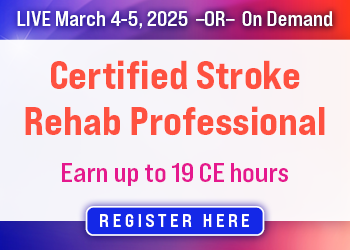Over the last 30 years, I’ve had the honor of working with patients, colleagues, and students around the world—helping to reshape what’s possible in stroke recovery. If you’re reading this, you’re likely dedicated to giving your patients the very best care. But even with years of experience, stroke rehabilitation can feel like a puzzle where the pieces don’t always fit.
We created this certification course to bridge that gap. It’s designed to help you move beyond traditional methods and embrace comprehensive, evidence-based strategies that can make a true impact. From cognition and motivation to sensory loss, spasticity, fear, and the latest advances in motor relearning and neuroplasticity, this course covers it all—equipping you with the tools you need to truly transform patient outcomes.
This isn’t just another course. It’s a way to truly expand your practice, empower your patients, and elevate your skills. Together, we’ll explore the comprehensive techniques that I’ve developed and refined over my career— tools that I’ve taught in every state, across four continents, and in ten countries.
If you’re ready to rethink stroke rehab, dive deep into cutting-edge practices, and give your patients the best chance at recovery, this certification program is here to guide you every step of the way.
$199.99 when you register by 2/20/25
Not sure of your schedule? No problem! Pre-order the self-study version here!
FREE BONUS! CSRP Certification (a $199.99 value) included!
Click here for course objectives and outline
- Get direct feedback on your toughest challenges
- Virtually network with colleagues across the country
- Access to all conference sessions for 30 days
- Earn up to 19 CE hours
- Completely flexible learning for your busy schedule
- Unlimited access to all conference sessions and handouts
- Up to 19 self-study CE hours
When you register, you'll join Mike Studer for an immersive 2-day learning experience, featuring live webinars and Q&A sessions, plus access to on-demand trainings. This comprehensive program is designed to equip you with the advanced skills needed to improve outcomes for stroke survivors.
In this course, you will:
- Investigate the mechanisms of neuroplasticity ― why and how the brain reorganizes
- Understand the difference in ischemic and hemorrhagic stroke ― and how that impacts rehab
- Debunk the myths of stroke: UE vs. LE; timing of rehab; and “where gains come from”
- Discover interventions for the physical and cognitive changes for UE and LE
- Explore spasticity vs tone: differences, precursors and the treatments for each
- Learning how to enhance patient compliance with principles of behavioral economics: gamification, nudge, confirmation bias, familiarity bias, and loss aversion
- Utilize cognitive rehabilitation: dual task tolerance, function, impulse control, affect & awareness
- Explore the future of stroke rehab: progress in technology and science
And best of all? You'll be eligible to become a Certified Stroke Rehabilitation Professional (CSRP)*, for no additional charge!
$199.99 when you register by 2/20/25
Not sure of your schedule? No problem! Pre-order the self-study version here!
FREE BONUS! CSRP Certification (a $199.99 value) included!
Click here for course objectives and outline
How to Maximize Functional Recovery
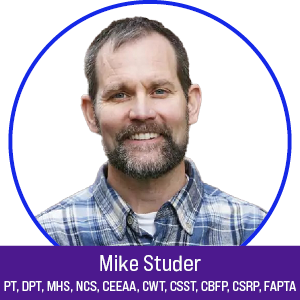
March 4: 9am-6pm central & March 5: 9am-2pm central
There will be two 15 minute breaks and a 45 minute lunch on Day 1; there will be a 45 minute lunch on Day 2
Featuring Mike Studer, PT, DPT, MHS, NCS, CEEAA, CWT, CSST, CBFP, CSRP, FAPTA
Click here for information about Mike Studer.- Mechanisms of neuroplasticity- why and how the brain reorganizes
- Recovery of motor control vs. compensations
- How the brain uses habituation, adaptation and compensation for functionality
- Therapeutic applications for introducing constraints, incentives and avoidances in neuroplasticity
- Understand the difference between ischemic and hemorrhagic stroke – and how that impacts rehab.
- When should rehab start? When can intensity start? When is someone “neurologically ready”?
- How your interventions promote change
- Debunk the myths of stroke: UE vs. LE; timing; and “where gains come from”
- Balance the elements challenge, gamification, success and failure to maximize neuroplasticity for each patient
- Apply autonomy as a catalyst for patient engagement
- Prime reward centers for possible success – beliefs are more important than we ever realized
- Shift to external, goal-focused feedback to increase retention for motor skills
- Spasticity vs tone: differences, precursors and the treatments for each
- Goal action coupling – and how this can deepen patient engagement
- Time spent, time expectations and repetitions are largely under-dosed for UE
- Why you may want to focus on the hand first instead of the shoulder
- Integrate tasks that force sensory information and motor contribution
- Induce neuroplasticity with graded motor imagery: L/R discrimination and mirror therapy
- Utilize bilateral challenges to increase mirror neuron benefit, intensity, gamification, accountability and functionality
- Forced use applications for UE
- Applications in overtraining: HIIT, error-enhanced learning and amplifying error
- Add a dual task to increase intensity and attention
- Forced use applications for LE
- HIIT and High-intensity gait training
- What is HIIT, what isn’t, and why we use it...
- Tools for assisted functional recovery: weight-bearing tasks in function: transfers, ADL, standing
- Defining improved gait... Independence, efficiency, quality, distance, speed?
- Novel clinical applications: motivational and exercise attributes
- Apply the principles of behavioral economics to movement: confirmation bias, nudge, gamification, familiarity bias, and loss aversion
- Self-efficacy is malleable and may be the most powerful variable across all severities of stroke
- Utilize the physiological tools of behavioral economics to apply nudge, gamification, and choice architecture
- Understand the dynamic balance of autonomy in treatment
- Fear: overcome with habituation, desensitization, reward cycle replacement, self-efficacy and wins.
- Robotics
- Virtual reality (VR) and Brain computer interfacing (BCI)
- Transcranial magnetic stimulation (TMS)
- HIIT, HIGT, task-specific circuit training, and early mobilization (acute care)
- The resurgence of comprehensive outpatient rehabilitation facilities (CORFs)
- Recognize the most common sequelae of cognitive, affective, and attentional impairments sustained in stroke
- How to constrain attentional resources to improve tolerance, function, and awareness
- 4 simple ways to enhance awareness and maximize attention
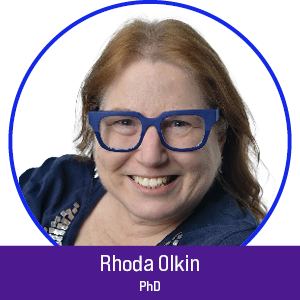
- Affirmative language to reflect the family’s model(s) of disability
- Common pitfalls in the use of assistive technology
- Incorporate the family system to maximize recovery and wellness
- Tools to manage cognitive issues
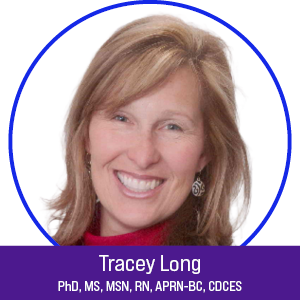
- Pathophysiology, treatment, and pharmacological management for diabetes, hyperlipidemia, and hypertension
- Explore the relationship between hypertension, hyperlipidemia, smoking, diabetes, and stroke
- Common pharmacology seen in rehab facilities
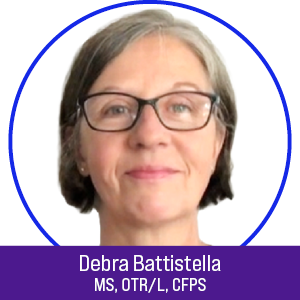
- Integrate visual feedback to stimulate neuroplasticity
- Cost-effective interventions to improve motor control, sensory awareness and ADL performance
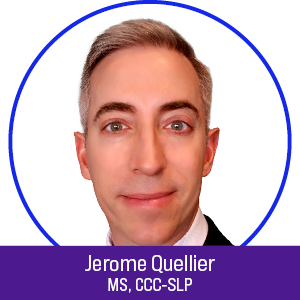
- Site-specific changes within the brain that affect behavior and thinking skills
- Predict patient barriers to engagement and compliance to enhance your treatment plan

-
“I loved the videos and clinical application/treatment ideas to help better apply and understand topics discussed in the course” - Brittany S, PT
-
"Such a well-presented course. Thank you for sharing your research, experience, and evidence supported approach. I have a lot of experience with PWS and I have lots to think about and new ideas to implement. I really enjoyed your course. ” - Becky K, PT
-
"Mike Studer was a very informed presenter and did a great job of providing new ideas, and evidence across the fields. As an OT, I learned a lot from this course!” Abigail P, OT
-
“Great, energetic speaker. Up to date knowledge. Caring and engaged in discussion and very helpful answering questions or providing resources. He even spent time over lunch to provide more resources to ensure we had a good understanding of a topic. It is wonderful to have a speaker that truly cares about the subject matter and wholeheartedly shares knowledge with participants. Thank you, Mike!” - Stacey C, PT
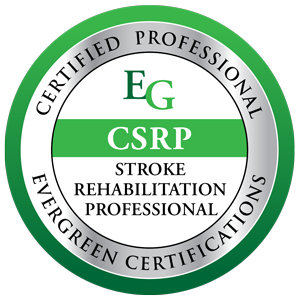 In just a few simple steps, you can become an Evergreen Certified Stroke Rehabilitation Professional (CSRP):
In just a few simple steps, you can become an Evergreen Certified Stroke Rehabilitation Professional (CSRP): Step 1: Complete this live interactive training and the additional self-study modules.
Step 2: Complete the CE tests and instantly print your certificates of completion.
Step 3: Submit the Certification Questionnaire included in this training to Evergreen Certifications and we'll cover the cost of your certification for the first year (a $199.99 value!).* Click here for full Certification requirements
That's it! No hidden fees. No catch. Just certification made EASY.
*Professional standards apply. Learn more at www.evergreencertifications.com/CSRP
$199.99 when you register by 2/20/25
Not sure of your schedule? No problem! Pre-order the self-study version here!
FREE BONUS! CSRP Certification (a $199.99 value) included!
Click here for course objectives and outline
We're that confident you'll find this learning experience to be all that's promised and more than you expected.

